Ritual purification
This article needs additional citations for verification. (November 2019) |

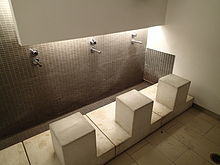
Ritual purification is a ritual prescribed by a religion through which a person is considered to be freed of uncleanliness, especially prior to the worship of a deity, and ritual purity is a state of ritual cleanliness. Ritual purification may also apply to objects and places. Ritual uncleanliness is not identical with ordinary physical impurity, such as dirt stains; nevertheless, body fluids are generally considered ritually unclean.
Most of these rituals existed long before the germ theory of disease, and figure prominently from the earliest known religious systems of the Ancient Near East. Some writers connect the rituals to taboos.
Some have seen benefits of these practices as a point of health and preventing infections especially in areas where humans come in close contact with each other. While these practices came before the idea of the germ theory was public in areas that use daily cleaning, the destruction of infectious agents seems to be dramatic.[dubious – discuss][1] Others have described a 'dimension of purity' that is universal in religions that seeks to move humans away from disgust (at one extreme), to uplift them towards purity and divinity (at the other extreme), away from uncleanliness to purity, and away from deviant to moral behavior (within one's cultural context).[2]
Baháʼí Faith
[edit]In the Baháʼí Faith, ritual ablutions (the washing of the hands and face) should be done before the saying of the obligatory prayers, as well as prior to the recitation of the Greatest Name 95 times.[3] Menstruating women are obliged to pray, but have the (voluntary) alternative of reciting a verse instead; if the latter choice is taken, ablutions are still required before the recital of the special verse. Bahá'u'lláh, the founder of the Baháʼí Faith, prescribed the ablutions in his book of laws, the Kitáb-i-Aqdas.[3]
These ablutions have a significance beyond washing and should be performed even if one has bathed oneself immediately before reciting the obligatory prayer; fresh ablutions should also be performed for each devotion, unless they are being done at the same time. If no water (or clean water) is available or if an illness would be worsened by the use of water, one may instead repeat the verse "In the Name of God, the Most Pure, the Most Pure" five times before the prayer.[3]
Apart from this, Bahá'u'lláh abolished all forms of ritual impurity of people and things, following Báb who stressed the importance of cleanliness and spiritual purity.[4]
Buddhism
[edit]
In Japanese Buddhism, a basin called a tsukubai is provided at Buddhist temples for ablutions. It is also used for tea ceremony.
This type of ritual cleansing is the custom for guests attending a tea ceremony[5] or visiting the grounds of a Buddhist temple.[6] The name originates from the verb tsukubau meaning "to crouch"[7] or "to bow down", an act of humility.[6] Guests attending a tea ceremony crouch and wash their hands in a tsukubai set in the tea garden before entering the tearoom.[7]
Tsukubai are usually of stone, and are often provided with a small ladle, ready for use.[7] A supply of water may be provided via a bamboo pipe[7] called a kakei.
The famous tsukubai shown here stands in the grounds of the Ryōan-ji temple in Kyoto, and was donated by the feudal lord Tokugawa Mitsukuni.[8] The kanji written on the surface of the stone are without significance when read alone. If each is read in combination with 口 (kuchi) - the shape of the central bowl - then the characters become 吾, 唯, 足, 知 which translates literally as "I only know plenty" (吾 = ware = I, 唯 = tada = only, 足 = taru = plenty, 知 = shiru = know).[9] The underlying meaning, variously translated as "what one has is all one needs",[9] or "learn only to be content"[8] reflects the basic anti-materialistic teachings of Buddhism.
Christianity
[edit]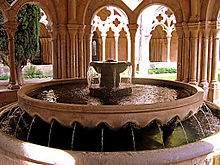
The Bible has many rituals of purification relating to menstruation, childbirth, sexual relations, nocturnal emission, unusual bodily fluids, skin disease, death, and animal sacrifices. Oriental Orthodox Churches such as the Coptic Orthodox, Ethiopian Orthodox, Eritrean Orthodox, places a heavier emphasis on Old Testament teachings, and its followers adhere to certain practices such as observing days of ritual purification.[10][11] Before praying, they wash their hands and face in order to be clean before and present their best to God.[12][13]
The Ethiopian Orthodox Tewahedo Church prescribes several kinds of hand washing for example after leaving the latrine, lavatory or bathhouse, or before prayer, or after eating a meal.[14] The women in the Ethiopian Orthodox Tewahedo Church are prohibited from entering the church temple during menses; and the men do not enter a church the day after they have had intercourse with their wives.[15]

Baptism, as a form of ritual purification, occurs in several religions related to Judaism, and most prominently in Christianity; Christianity also has other forms of ritual purification. Many Christian churches practice a ceremony of the Washing of Feet,[16] following the example of Jesus in the Gospel.[17] Some interpret this as an ordinance which the church is obliged to keep as a commandment, see also Biblical law in Christianity.[16] Others interpret it as an example that all should follow. Most denominations that practice the rite will perform it on Maundy Thursday. Often in these services, the bishop will wash the feet of the clergy, and in monasteries the Abbot will wash the feet of the brethren.
Many ancient churches were built with a large fountain in the courtyard. It was the tradition for Christians to wash before entering the church for worship.[18] This usage is also legislated in the Rule of St. Benedict, as a result of which, many medieval monasteries were built with communal lavers for the monks or nuns to wash up before the Daily Office. Catholic religious orders of the Augustinians' and Benedictines' rules contained ritual purification,[19] and inspired by Benedict of Nursia encouragement for the practice of therapeutic bathing; Benedictine monks played a role in the development and promotion of spas.[20]
The principle of washing the hands before celebrating the holy Liturgy began as a practical precaution of cleanness, which was also interpreted symbolically.[21] "In the third century there are traces of a custom of washing the hands as a preparation for prayer on the part of all Christians, and from the fourth century onwards it appears to have been usual for the ministers at the Holy Mass or divine liturgy ceremonially to wash their hands before the more solemn part of the service as a symbol of inward purity."[22]
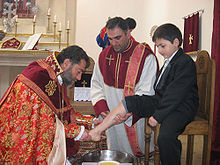
Traditionally, Christianity adhered to the biblical regulation requiring the purification of women after childbirth; this practice, was adapted into a special ritual known as the churching of women, for which there exists liturgy in the Church of England's Book of Common Prayer, but its use is now rare in Western Christianity. The churching of women is still performed in a number of Eastern Christian churches (Eastern Orthodox, Oriental Orthodox and Eastern Catholic churches).
A cantharus is a fountain used by Christians for ablution before entering a church.[23][24][25] These ablutions involve the washing of the hands, face, and feet.[25] The cantharus is traditionally located in the exonarthex of the church.[24][26] The water emitted by a cantharus is to be running water.[27] The practice of ablutions before prayer and worship in Christianity symbolizes "separation from sins of the spirit and surrender to the Lord."[26] Eusebius recorded this practice of canthari located in the courtyards of churches, for the faithful to wash themselves before entering a Christian house of worship.[25] The practice has its origins Jewish practice of performing ablutions before entering into the presence of God (cf. Exodus 30:17–21).[24][23] Though cantharus are not as prevalent anymore in Western Christianity, they are found in Eastern Christian and Oriental Christian churches.[23] However, in the Latin liturgical rites of the Catholic Church, worshippers sprinkle themselves with holy water before entering the nave of the Church or approaching the altar.[citation needed]
In Reformed Christianity, ritual purity is achieved through the Confession of Sins, Assurance of Forgiveness, and Sanctification. Through the power of the Holy Spirit, believers offer their whole being and labor as a 'living sacrifice'; and cleanliness becomes a way of life (See Romans 12:1, and John 13:5-10 (the Washing of the Feet)). Prior to praying the canonical hours at seven fixed prayer times, Oriental Orthodox Christians wash their hands, face and feet (cf. Agpeya, Shehimo).[28][12][29]
The use of water in many Christian countries is due in part to the Biblical toilet etiquette which encourages washing after all instances of defecation.[30] The bidet is common in predominantly Catholic countries where water is considered essential for anal cleansing,[31][32] and in some traditionally Orthodox and Lutheran countries such as Greece and Finland respectively, where bidet showers are common.[33]
Hinduism
[edit]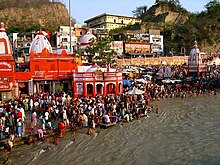
Various traditions within Hinduism follow different standards of ritual purity and purification. Within each tradition the more orthodox groups follow stricter rules, but the strictest rules are generally prescribed for Brahmins, especially those engaged in the temple worship.
An important part of ritual purification in Hinduism is the bathing of the entire body, particularly in rivers considered holy such as the Ganges. It is considered auspicious to perform this method of purification before festivals after a death, in order to maintain purity.
Punyahavachanam is a ritual meant to purify one's self and one's home, usually performed before important occasions, like weddings. During the ceremony, mantras are chanted and then consecrated water is sprinkled over all of the participants and the items used.
In the ritual known as abhisheka (Sanskrit, "sprinkling; ablution"), the deity's murti or image is ritually bathed with water, curd, milk, honey, ghee, cane sugar, rosewater, etc. Abhisheka is also a special form of puja prescribed by Agamic injunction. The act is also performed in the inauguration of religious and political monarchs and for other special blessings. The murtis of deities must not be touched without cleansing the hands, and one is not supposed to enter a temple without a bath.[citation needed]
Sūtaka are the Hindu rules of impurity to be followed after the birth of a child (vṛddhi sūtaka).[34] Sūtaka involves the practice of keeping socially isolated from relatives and community by abstention of mealtaking with family, engaging in customary religious activities, and leaving the home. A mother must practice sūtaka for 10 to 30 days, depending upon her varna, while the father may become purified immediately after the birth of his child by ritual purification (ritual bathing).[35]
There are various kinds of purificatory rituals associated with death ceremonies. After visiting a house where a death has recently occurred, Hindus are expected to take baths.
Women take a head bath after completing their four-day menstrual period.
Indigenous American religions
[edit]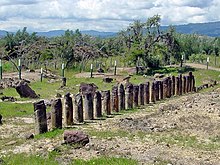
In the traditions of many Indigenous peoples of the Americas, one of the forms of ritual purification is the ablutionary use of a sauna, known as a sweatlodge, as preparation for a variety of other ceremonies. The burning of smudge sticks is also believed by some indigenous groups to cleanse an area of any evil presence. Some groups like the southeastern tribe, the Cherokee, practiced and, to a lesser degree, still practice going to water, performed only in moving bodies of water such as rivers or streams. Going to water was practiced by some villages daily (around sunrise) while others would go to water primarily for special occasions, including but not limited to naming ceremonies, holidays, and ball games.[36] Many anthropologists that studied with the Cherokees like James Adair tried to connect these groups to the Lost Tribes of Israel based on religious practices including going to water,[37] but this form of historiography is mostly Christian "wish fulfillment" rather than respectable anthropology.
Yuquot Whalers' Shrine on Vancouver Island was used by chiefs to prepare ritually for whaling.
Islam
[edit]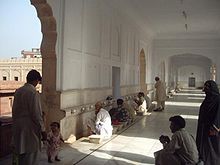
Islamic ritual purification is particularly centred on the preparation for salah, ritual prayer; theoretically ritual purification would remain valid throughout the day, but is treated as invalid on the occurrence of certain acts, flatulence, sleep, contact with the opposite sex (depending on which school of thought), unconsciousness, and the emission of blood, semen, or vomit. Some schools of thought mandate that ritual purity is necessary for holding the Quran.
Ritual purification takes the form of ablution, wudu and ghusl, depending on the circumstance; the greater form is obligatory by a woman after she ceases menstruation, on a corpse that did not die during battle, and after sexual activity, and is optionally used on other occasions, for example just prior to Friday prayers or entering ihram.
An alternative tayammum ("dry ablution"), involving clean sand or earth, is used if clean water is not available or if an illness would be worsened by the use of water; this form is invalidated in the same circumstances as the other forms, and also whenever water becomes available and safe to use.
The fard or "obligatory activities" of the lesser form include beginning with the intention to purify oneself, washing of the face, arms, head, and feet. while some mustahabb "recommended activities" also exist such as basmala recitation, oral hygiene, washing the mouth, nose at the beginning, washing of arms to the elbows and washing of the ears at the end; additionally recitation of the Shahada. The greater form (ghusl) is completed by first performing wudu and then ensuring that the entire body is washed. Some minor details of Islamic ritual purification may vary between different madhhabs "schools of thought".
Judaism
[edit]
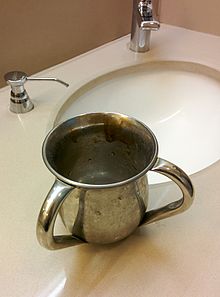
The Hebrew Bible mentions a number of situations when ritual purification is required, including following menstruation (niddah), childbirth, sexual relations, nocturnal emission, unusual bodily fluids, skin disease, death (corpse uncleanness), and certain animal sacrifices. Generally, the ritual in these circumstances consists of immersing the whole body in a special bath (a mikveh). In addition, the oral law specifies other situations when ritual purification is required, such as after performing excretory functions, meals, and waking. In these circumstances, typically, only the hands are washed.
These regulations were variously observed by the Israelites. Purification was required so ritually impure individuals would not defile the Tabernacle and receive the kareth or execution.[38] Nowadays, in the absence of the Temple in Jerusalem, many of the Torah's laws about purification have no practical implication and are no longer observed. However, purification from the niddah status is still observed by contemporary Orthodox Jews and (with some modifications and additional leniencies) some Conservative Jews, as its practical implications are highly relevant: a woman who is impure with this status is forbidden to have sexual contact with her husband.
Corpse uncleanness, or coming into contact with a corpse, is considered the ultimate impurity. It cannot be purified through immersion in a mikveh alone, but also requires sprinkling with the ashes of the red heifer.[39] Since the red heifer no longer exists, this form of impurity cannot be removed. Currently, all individuals are assumed to possess the impurity of death.[40] This has a few practical implications: it prohibits Jews from entering the site of the Temple in Jerusalem and prohibits eating certain foods (such as terumah) which may only be eaten when pure.
Mandaeism
[edit]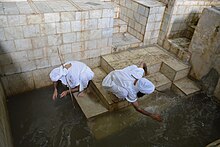
One of the most important ceremonies in Mandaean worship is baptism (masbuta). Unlike Christianity, baptism is not a one-off event but is performed every Sunday, the Mandaean holy day, as a purification ritual. Baptism usually involves full immersion in flowing water, and all rivers considered fit for baptism are called yardna for the Jordan River. After emerging from the water, the worshipper is anointed with holy sesame oil (misha) and partakes in a communion of sacramental bread (pihta) and water. Other rituals for purification include the rishama and the tamasha which, unlike masbuta, can be performed without a priest.[41] The rishama (signing) is performed before prayers and involves washing the face and limbs while reciting specific prayers. It is performed daily, before sunrise, with hair covered and after evacuation of bowels or before religious ceremonies[42] (see wudu). The tamasha is a triple immersion in the river without a priest being required to do it. Women perform it after menstruation or childbirth, men and women after sexual activity or nocturnal emission, touching a corpse or any other type of defilement[42] (see tevilah). Ritual purification also applies to fruits, vegetables, pots, pans, utensils, animals for consumption and ceremonial garments (rasta).[42] Purification for a dying person is also performed. It includes bathing, which involves a threefold sprinkling of river water over the person from head to feet.[42]
Shinto
[edit]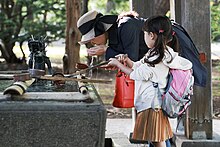
Ritual cleanliness is a central part of Shinto life.[43] In Shinto, a common form of ritual purification is misogi,[44][45] which involves natural running water, and especially waterfalls. Rather than being entirely naked, men usually wear Japanese loincloths and women wear kimono, both additionally wearing headbands.[44][45]
Western esotericism
[edit]In ceremonial magic, 'banishing' refers to one or more rituals intended to remove non-physical influences ranging from spirits to negative influences.[46] Although banishing rituals are often used as components of more complex ceremonies, they can also be performed by themselves. Banishing can be viewed as one of several techniques of magic, closely related to ritual purification and a typical prerequisite for consecration and invocation.
In the Hermetic Order of the Golden Dawn, the Lesser Ritual of the Pentagram (banishing: LBRP; invoking: LIRP) must be learned by the Neophyte[broken anchor] before moving on to the next grade (Zelator[broken anchor]).[47][48] For actual workings Aleister Crowley recommends a short, general banishing, with a comment that "in more elaborate ceremonies it is usual to banish everything by name."[46] In Liber Aleph vel CXI, Crowley recommended that a banishing ritual be done at least once daily by Thelemites.[49]
In Wicca and various forms of neopaganism, banishing is performed before casting a circle in order to purify the area where the ritual or magick is about to take place. In his books on nocturnal witchcraft, for example, Konstantinos recommends performing banishings regularly, in order to keep the magical workspace free of negativity, and to become proficient in banishing before attempting acts that are much more spiritually taxing on the body, such as magical spellworking.[50]
See also
[edit]- Bathing the dead
- Churching of women
- Eleusinian Mysteries
- Lady Macbeth effect
- Law of contagion
- Lustral basin
- Water and religion
References
[edit]Citations
[edit]- ^ "Nitten Soji and the prevention of infections" Classical fighting arts vol 2 #18
- ^ Haidt, Johnathan (12 February 2010). The Happiness Hypothesis. Basic Books.
- ^ a b c Smith, Peter (2000). "ablutions". A Concise Encyclopedia of the Baháʼí Faith. Oxford: Oneworld Publications. pp. 21–22. ISBN 1-85168-184-1.
- ^ Smith, Peter (2000). "purity". A Concise Encyclopedia of the Baháʼí Faith. Oxford: Oneworld Publications. pp. 281–282. ISBN 1-85168-184-1.
- ^ Must See in Kyoto. Kyoto: Japan Travel Bureau, Inc. 1991. p. 107. ISBN 4-533-00528-4.
- ^ a b Einarsen, John (2004). Zen and Kyoto. Kyoto: Uniplan Co, Inc. p. 133. ISBN 4-89704-202-X.
- ^ a b c d Setsuko, Kojima; Crane, Gene A (1991). Dictionary of Japanese Culture (1st American ed.). Union City, CA: Heian. pp. 369–70. ISBN 0893463361. OCLC 23738000.
- ^ a b Einarsen, John (2004). Zen and Kyoto. Kyoto: Uniplan Co, Inc. pp. 90–91. ISBN 4-89704-202-X.
- ^ a b "Tsukubai and Zenibachi, the Japanese Water Basins". Archived from the original on 1 April 2019. Retrieved 3 March 2016.
- ^ Ian Bradley (2 November 2012). Water: A Spiritual History. Bloomsbury Publishing. ISBN 978-1-4411-6767-5.
- ^ H. Bulzacchelli, Richard (2006). Judged by the Law of Freedom: A History of the Faith-works Controversy, and a Resolution in the Thought of St. Thomas Aquinas. University Press of America. p. 19. ISBN 9780761835011.
The Ethiopian and Coptic Churches distinguishes between clean and unclean meats, observes days of ritual purification, and keeps a kind of dual Sabbath on both Saturday and Sunday.
- ^ a b Mary Cecil, 2nd Baroness Amherst of Hackney (1906). A Sketch of Egyptian History from the Earliest Times to the Present Day. Methuen. p. 399.
Prayers 7 times a day are enjoined, and the most strict among the Copts recite one of more of the Psalms of David each time they pray. They always wash their hands and faces before devotions, and turn to the East.
{{cite book}}: CS1 maint: numeric names: authors list (link) - ^ Dawood, Bishoy (8 December 2013). "Stand, Bow, Prostrate: The Prayerful Body of Coptic Christianity". The Clarion Review. Archived from the original on 10 August 2020. Retrieved 6 August 2020.
Standing facing the East is the most frequent prayer position. ... This is further emphasized in the fact that Copts pray facing the East, waiting for the return of Jesus in glory; his return as the enthroned Pantocrator is portrayed in the iconography that is placed before the worshippers.
- ^ "Is THE CHURCH OF ETHIOPIA A JUDAIC CHURCH ?" (PDF). Archived from the original (PDF) on 4 March 2016. Retrieved 15 January 2016.
- ^ The Liturgy of the Ethiopian Orthodox Tewahedo Church
- ^ a b Peter C. Bower (January 2003). The Companion to the Book of Common Worship. Geneva Press. ISBN 9780664502324. Retrieved 11 April 2009.
Maundy Thursday (or le mandé; Thursday of the Mandatum, Latin, commandment). The name is taken from the first few words sung at the ceremony of the washing of the feet, "I give you a new commandment" (John 13:34); also from the commandment of Christ that we should imitate His loving humility in the washing of the feet (John 13:14–17). The term mandatum (maundy), therefore, was applied to the rite of foot-washing on this day.
- ^ John 13:1–17
- ^ The Holy Rule of St. Benedict
- ^ Hembry, Phyllis (1990). The English Spa, 1560-1815: A Social History. Fairleigh Dickinson Univ Press. ISBN 9780838633915.
- ^ Bradley, Ian (2012). Water: A Spiritual History. Bloomsbury Publishing. ISBN 9781441167675.
- ^ Fortescue, Adrian. "Lavabo." The Catholic Encyclopedia Vol. 9. New York: Robert Appleton Company, 1910. 12 July 2017
- ^ Report of the Royal Commission on Ecclesiastical Discipline (Church of England) 1906
- ^ a b c Ian Bradley (2 November 2012). Water: A Spiritual History. Bloomsbury Publishing. ISBN 978-1-4411-6767-5.
It was probably out of the Jewish rite that the practice developed among early Christians, especially in the east, of washing their hands and feet before going into church. Early Christian basilicas had a fountain for ablutions, known as cantharus or phiala, and usually placed in the centre of the atrium. They are still found in some Eastern Orthodox churches, notably at the monastery of Laura at Mount Athos, where the phiala is an imposing structure in front of the entrance covered by a dome resting on eight pillars. In several Orthodox churches today worshippers take off heir shoes and wash their feet before entering the church just as Muslims do before going into a mosque.
- ^ a b c Soloviĭ, Meletiĭ M. (1970). Eastern Liturgical Theology: General Introduction. Ukrainian Catholic Religion and Culture Society of Etobicoke (Toronto) and Ukrainian Catholic Youth of Canada. p. 68.
In the Book of Exodus (30, 18-20) Aaron and his sons were required to wash before approaching the altar. Here water is used as a symbol of purification and expiation. But water is also the most common and most indispensable drink. ... So much was the practice a part of the life of the early Church, that in the period after Constantine the "cantharus", or water fountain, became a standard fixture in the courtyard before the basilica to permit the faithful to purify themselves before entering the presence of God.
- ^ a b c Bingham, Joseph (1840). The antiquities of the Christian Church. W. Straker. p. 396.
In the middle of which stood a Fountain for washing as they entered into the Church, called Cantharus and Phiala in some authors. It is further to be noted, that in the middle of the atrium, there was commonly a fountain, or a cistern of water, for people to wash their hands and face, before they went into the church.
- ^ a b Ferguson, Everett (8 October 2013). Encyclopedia of Early Christianity: Second Edition. Routledge. p. 6. ISBN 978-1-136-61158-2.
- ^ Lowrie, Walter (1901). Christian Art and Archæology: Being a Handbook to the Monuments of the Early Church. Macmillan Publishers. p. 179.
In the middle of this court there was as a rule a fountain of running water (the cantharus) for the symbolical purification of those who ere about to enter the church.
- ^ Smith, Bertha H. (1909). "The Bath as a Religious Rite among Mohammedans". Modern Sanitation. 7 (1). Standard Sanitary Mfg. Co.
The Copts, descendants of these ancient Egyptians, although Christians, have the custom of washing their hands and faces before prayer, and some also wash their feet.
- ^ Tadros, Emile (2015). Reconstruction the Origins of the Coptic Church through its Liturgy. McMaster Divinity College. p. 16.
The Coptic Church observes strict practices concerning circumcision, rituals surrounding menstruation, weekly two-days fasting, 40 ablution, and many other rituals.
- ^ E. Clark, Mary (2006). Contemporary Biology: Concepts and Implications. University of Michigan Press. ISBN 9780721625973.
- ^ E. Clark, Mary (2006). Contemporary Biology: Concepts and Implications. University of Michigan Press. p. 613. ISBN 9780721625973.
Douching is commonly practiced in Catholic countries. The bidet ... is still commonly found in France and other Catholic countries.
- ^ Made in Naples. Come Napoli ha civilizzato l'Europa (e come continua a farlo) [Made in Naples. How Naples civilised Europe (And still does it)] (in Italian). Addictions-Magenes Editoriale. 2013. ISBN 978-8866490395.
- ^ "Bidets in Finland"
- ^ Turner, R. L. (1999). A Comparative Dictionary of the Indo-Aryan Languages. Motilal Banarsidass Publisher. p. 781. ISBN 978-81-208-1665-7.
- ^ Textbook of the 'University of Spirituality', Volume 61, Death and Post-Death Rites, by Parātpar Guru (Dr) Athavale and H.H. (Mrs.) Anjali http://sanatanshop.com/shop/en/booklets/383-death-and-post-death-rites.html
- ^ The Sacred Formulas of the Cherokee by James Mooney 1891
- ^ The History of The American Indians by James Adair 1775
- ^ Leviticus 15:31; Numbers 19:20
- ^ Rowman, Altamira (2004). The Inclusive Hebrew Scriptures: The Torah. Rowman & Littlefield Publishers, Inc. p. 241. ISBN 0-9644279-6-6. Retrieved 11 April 2015.
- ^ Rutta, Matt (30 March 2008). "Shemini/Parah (The smell of burning death)". Rabbinic Rambling. Retrieved 6 May 2009.
- ^ Drower, Ethel Stefana. The Mandaeans of Iraq and Iran. Oxford At The Clarendon Press, 1937
- ^ a b c d Mandaean Awareness and Guidance Board (28 May 2014). "Mandaean Beliefs & Mandaean Practices". Mandaean Associations Union. Retrieved 13 November 2021.
- ^ Ono, Sakyo. Shinto: The Kami Way. Pp 51–52, 108. Tuttle Publishing. 2004. ISBN 0-8048-3557-8
- ^ a b Bocking 1997, p. 93; Cali & Dougill 2013, p. 20.
- ^ a b Nelson 1996, p. 101; Bocking 1997, p. 45; Cali & Dougill 2013, p. 21.
- ^ a b Crowley, Aleister. Magick in Theory and Practice. pp. 103–6.
- ^ The Golden Dawn by I. Regardie
- ^ "Golden Dawn Neophyte Knowledge Lecture". Archived from the original on 17 November 2002. Retrieved 7 May 2011.
- ^ Crowley, Aleister. Liber Aleph vel CXI. A.:.A.:.
- ^ Konstantinos.Nocturnal Witchcraft: Magick After Dark. St. Paul, Minn:Llewellyn Publications, 2002.
Sources
[edit] This article incorporates text from a publication now in the public domain: Herbermann, Charles, ed. (1913). "Lavabo". Catholic Encyclopedia. New York: Robert Appleton Company.
This article incorporates text from a publication now in the public domain: Herbermann, Charles, ed. (1913). "Lavabo". Catholic Encyclopedia. New York: Robert Appleton Company.- Bocking, Brian (1997). A Popular Dictionary of Shinto (revised ed.). Richmond: Curzon. ISBN 978-0-7007-1051-5.
- Cali, Joseph; Dougill, John (2013). Shinto Shrines: A Guide to the Sacred Sites of Japan's Ancient Religion. Honolulu: University of Hawai'i Press. ISBN 978-0-8248-3713-6.
- Nelson, John K. (1996). A Year in the Life of a Shinto Shrine. Seattle and London: University of Washington Press. ISBN 978-0-295-97500-9.
External links
[edit] Media related to Water in religion at Wikimedia Commons
Media related to Water in religion at Wikimedia Commons
